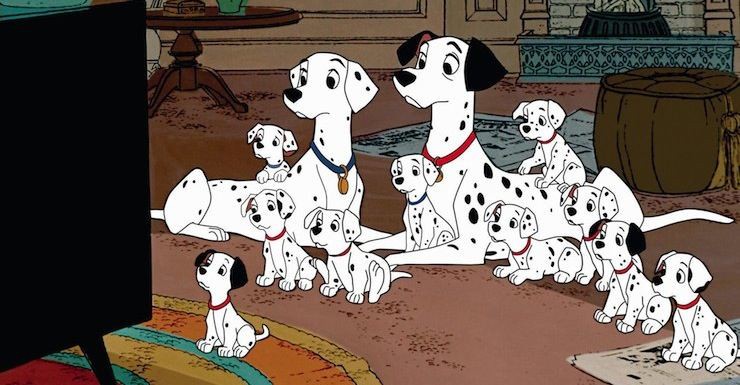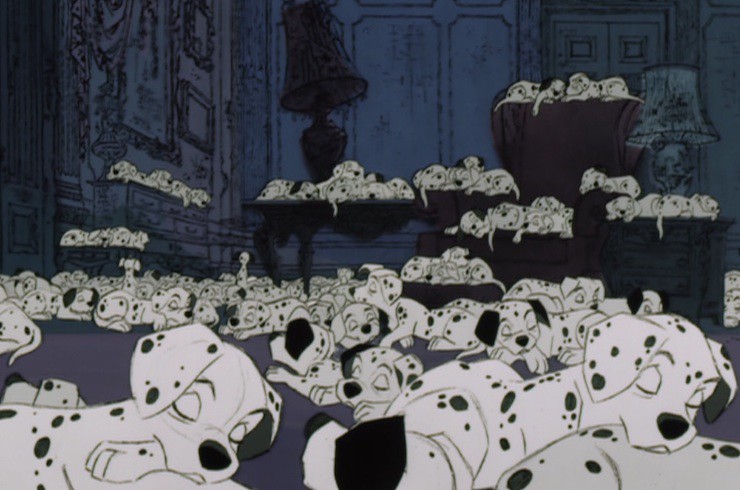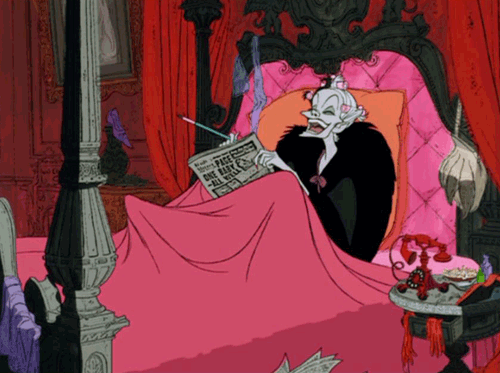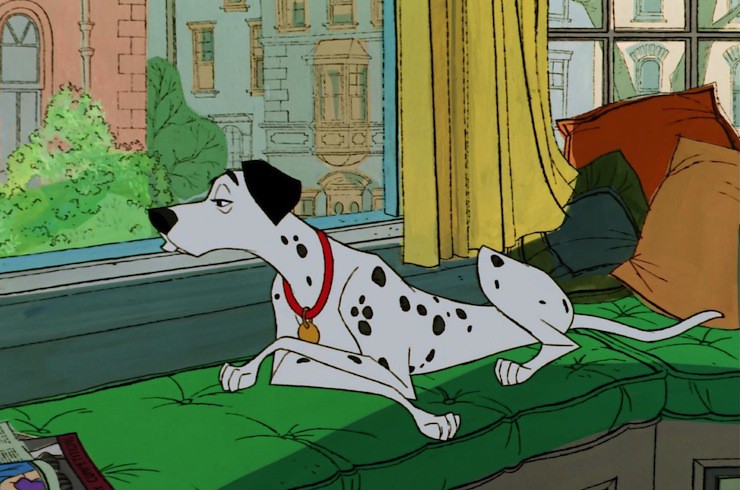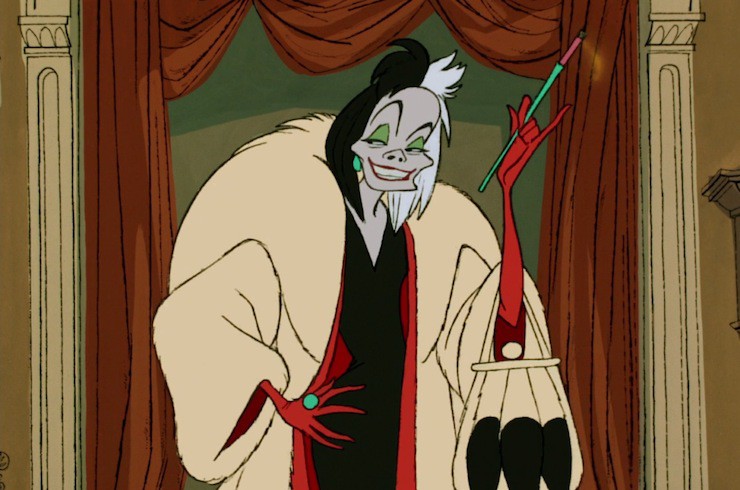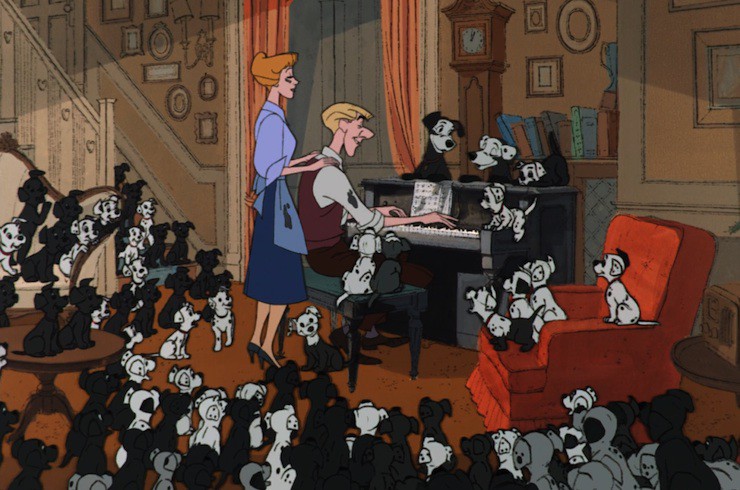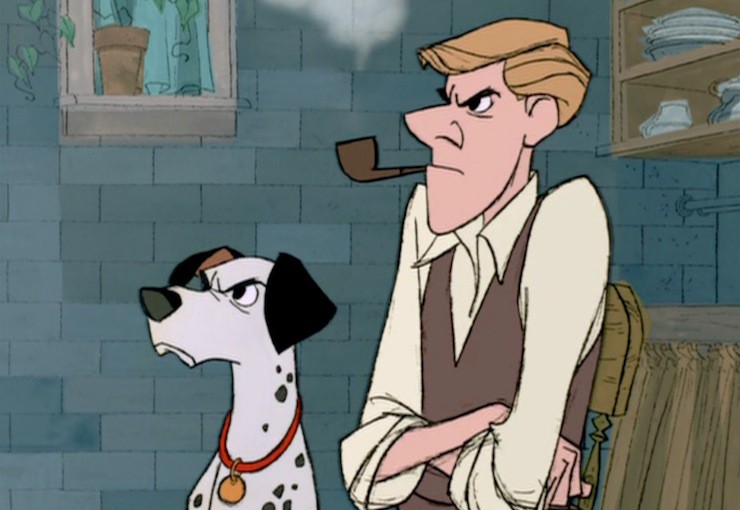After the expensive financial flop that was Sleeping Beauty, Walt Disney seriously considered shutting down his studio’s animation division. Fewer than half of his animated films had been financial successes, after all, and although World War II could certainly be blamed for some of that, it could not be blamed for the financial failures of the post war Alice in Wonderland and Sleeping Beauty, or the only middling financial success of Lady and the Tramp, which for technical reasons had been issued in two versions, adding greatly to the film’s budget—and cutting into profits.
But Walt Disney had also picked up Dodie Smith’s The Hundred and One Dalmatians and loved it. It had everything needed for a major Disney hit: a grandiose, over the top villain, a tight, simple plot, adorable puppies, and a happy ending. Oh, a few things would need changing – that almost but not quite doggie threesome between Pongo, Missus and Perdita would just not work for a children’s film aimed at an American audience, in his opinion, and some of the characters would have to go. And the final scenes needed something more. Maybe a car chase. An over the top car chase. That could work.
That left just one problem: how to animate 99 puppies. With spots. Without repeating the financial issues of Lady and the Tramp and the outright disaster that was the gloriously detailed work of Sleeping Beauty.
Xerox had begun developing a photocopying process before Word War II. By the 1950s, a commercial version was available for businesses, but it focused on paper, not film. Ub Iwerks (the co-creator, with Walt Disney, of Mickey Mouse) was impressed enough by what he saw to work with Xerox to adapt the technology for film, and the final process allowed animator drawings to be printed directly onto cels. This accomplished two things: one, it freed Disney from the need to hand ink each and every animated cel (the process which had significantly raised the costs of Alice in Wonderland and Sleeping Beauty, and the costs of releasing two versions of Lady and the Tramp) and it meant that instead of having to hand draw 99 little Dalmatian puppies, Disney could, for all intents and purposes, just photocopy them.
The resulting process did lead to some sloppiness: if you watch the Blu-Ray edition closely, and even not all that closely, you can still see the original pencil marks around some of those black lines. The lines, too, are far thicker than the delicate lines used in earlier Disney animated pictures, something that would not be improved until The Rescuers (1977), and often uneven. This might be the one Disney film you’re better off not seeing in Blu-Ray, is what I’m saying. It also reportedly led to one error: viewers who have counted all of the puppies in the final scene have claimed that it has about 150 puppies, not 99, probably thanks to the ease of photocopying the puppies. (I didn’t try to verify this.)
And since the xerography process could initially only reproduce black, not colored lines, animated characters from One Hundred and One Dalmatians through The Rescuers, and even most of the characters in The Rescuers and later films, were all outlined in black, in strong contrast to the colored outlines that Disney had used to such great effect in Fantasia and some of the Sleeping Beauty sequences. It also forced animators to move away from the more realistic animation used for the dogs in Lady and the Tramp (which did not have to be drawn with hard, black lines) to a more cartoonish look used for One Hundred and One Dalmatians and pretty much every animated animal in a Disney film until Beauty and the Beast in 1991.
Walt felt it was a step back to earlier, cruder animation techniques, and disliked it. But if less artistic, xerography was also considerably cheaper, saving Disney millions in production costs. The process was so successful that Disney almost completely abandoned the process of hand inked cels, using xerography for almost all of their features from The Sword in the Stone until The Little Mermaid, until the process was again replaced for The Rescuers Down Under and further films by a new system called CAPS, developed by a little firm called Pixar. Xerography was efficient enough that, with one major exception that we’ll get to, even films that did not do particularly well at the box office could still break even.
Perhaps not coincidentally, however, the films produced in the 28-years between One Hundred and One Dalmatians and The Little Mermaid, with the very arguable exceptions of The Many Adventures of Winnie the Pooh and The Rescuers, are less well regarded, both in critical and popular opinion. Perhaps because the earlier films were all, for a lack of better term, “hand created,” versus the later, “machine created” films – although films from The Little Mermaid onward also used computer animation and other “machine created” images. Perhaps because, as we’ll see, One Hundred and One Dalmatians really does mark a general decline in Disney animation that, despite bright moments here and there, continued up until Who Framed Roger Rabbit and The Little Mermaid in the late 1980s.
Or perhaps because these films have been seen as “cartoons,” not “art,” – a perception that Disney itself tends to perpetuate. The Disney Art stores that dot the Disney theme parks, for instance, typically sell art focused almost entirely on the films before Sleeping Beauty and after The Little Mermaid (along with Mickey Mouse and Winnie the Pooh) ignoring the multiple films that came in between. This isn’t entirely because of a cartoon versus art approach, of course – the Disney Art stores also tend to focus on popular characters, and for whatever reason, characters from, say, The Sword and the Stone do not sell merchandise, high art or not. But still, head into a Disney Art store, and you will generally be left with the impression that the films from One Hundred and One Dalmatians through Oliver and Company are not classified as “art.”
But for One Hundred and One Dalmatians, which featured three cartoonish villains, the cartoonish look worked. It helped, certainly, that most of the dogs in the film were black and white, or, for a short period at the film’s end, very black and covered in soot. Also helping the budget and the overall look of the film: simple backgrounds, the nearly complete abandonment (in this film) of any attempt to give most scenes a three dimensional look, and a tight rewriting of the plot to ensure that the background artists in this film did not have to paint all that many backgrounds.
But also helping was one element that Disney could not take complete responsibility for: Cruella de Vil, the sort of person who not only wants to KILL PUPPIES (gasp) but also PUTS HER CIGARETTES OUT IN PEOPLE’S CUPCAKES. Really, Cruella. I get your point about having an existence so miserable that only a fur coat made with the finest, softest puppy fur can cheer you up, but what did those cupcakes ever do to you? For that matter, did it occur to you that just maybe, a cupcake or two would have made your existence slightly less miserable?
Most of her characterization is lifted from the book, right down to the black and white hair, the atrocious manners, the puppy obsession, and the terrible driving. Oh, a few elements were toned down – notably the hints that she’s a direct descendent of an actual devil, possibly not something that Disney wanted to include in a film largely aimed at young American children. And Cruella is – very arguably – slightly more sympathetic here. She doesn’t put pepper in everyone’s food, which is nice; she admits that she lives a miserable, sad existence (possibly, Cruella, because you haven’t figured out that happiness is a nice warm puppy—which is not exactly the same thing as a nice warm coat made from puppies); and she has to deal with two highly incompetent henchmen.
Against this, she’s also a lot meaner than she was in the book. She makes fun of Roger’s songwriting career. I may possibly have clapped out loud when Roger’s revenge song “Cruella de Vil, Cruella de Vil” turns out to be a major hit. She’s dismissive towards Anita and rude to poor Nanny. She splatters ink over Pongo and Roger – ok, it’s funny, but it’s also cruel. And she hits her two incompetent henchmen. A lot. I mean, I get her frustration, but when the two of them decided to watch TV instead of carrying out her orders, I was completely on their side. She smokes constantly, and, given her carelessness with cigarettes, I have no idea why she isn’t constantly set on fire. And she is the worst driver ever. In many ways the biggest question of the film is: how did Cruella not kill puppies with her car before this? Or did she, and the police were just to terrified of her to arrest her? I could see that.
But the best thing about Cruella, from Disney’s point of view, is that she is so cartoonish and over the top that the rest of the film could be designed to have a similar feel, and look – leading to the budget savings in animation noted above. And she made adults laugh – even as their children desperately worried about the puppies, partly because of her physical movements, partly because of her dialogue and voicing. Betty Lou Gerson would later be named a Disney Legend for voicing the part, possibly because of her marvelous way of shrieking “IMBECILE!” in a lovely accent straight from the BBC – well, if BBC News ever got that excited or decided to go on a puppy rampage.
If Disney mostly stayed with the book Cruella, they did, however, make other changes: turning Roger from a government financial wizard to a songwriter –allowing Disney to sneak two songs into the film; eliminating one of the Nannies, and also, alas, eliminating the decision made by the Nannies to take over traditional male jobs; allowing Colonel Tibbs the cat to start rescuing the puppies before Pongo and Perdita show up.
All small changes, but it was enough to upset small me – I saw it right after reading the book for the first time, and well before I’d learned that Hollywood always changes books, so my little hopes of getting to see my book on screen were completely dashed. I wanted Missis and Perdita and both Nannies and – and I’m afraid that my childhood disappointment hasn’t quite gone away.
And, as Tor.com readers pointed out in the last post, it is somewhat eyebrow raising that, with the exception of Mr. De Vil, the minor characters Disney chose to eliminate mostly happen to be women – and more specifically, women in non-traditional roles: Nanny Butler, who dons the uniform of a male butler without a blink, and does her work efficiently and with style; Willow, a military cat transformed to, well, a male military cat.
All this said, the rest of the film has held up relatively well, thanks to sight gags of dogs that resemble their owners, lots of adorable puppies, quick cameos from the dogs of Lady and the Tramp, a glorious moment where the dogs of London join together to save the puppies through barking (to the distress of their human pets), Cruella slapping incompetent people across the face, and the cartoon parodies of 1950s television, slightly expanded in the recent Blu-Ray edition. Contemporary audiences loved all this as well. One Hundred and One Dalmatians was an immediate financial success, though it did generate some unexpected criticism from one corner: Dalmatian experts concerned that small children would demand small but high energy Dalmatian puppies without necessarily knowing how to care for them. These concerns proved somewhat valid, and in turn led to the creation of several Dalmatian puppy rescue organizations.
For Disney, which only had to worry about cartoon dogs, not real ones, the financial success saved the animation studio. It also encouraged the studio to focus on two things that had so far seemed profitable: animated features based on British properties, and adorable animals. The Sword in the Stone, coming up next.
Mari Ness lives in central Florida.










